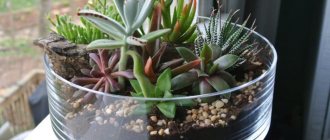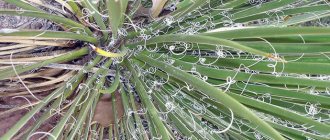Pachistachys was brought to Europe by travelers from the tropical forests of America. Under natural conditions, the flower can also be found in eastern India and in the coastal forests of Australia. The exotic plant is a representative of the Acanthus family; in its genus, according to various sources, there are from 12 to 17 species of perennial evergreen shrubs up to 1-2 meters in height.
Pachistachis is a lush bush with branched erect stems, on which rather large dark green leaves are attached oppositely. They are oval in shape with a pointed tip, and their length reaches 12 cm. Clearly visible veins give the leaves a special decorative appearance, making the leaf plate look slightly ribbed.
The plant received its name, which means “thick ear,” due to the shape of the spike-shaped inflorescences. Interestingly, they are nothing more than bracts consisting of many sepals, which are most often colored yellow-orange. In appearance, the inflorescences resemble curly pointed candles about 12 cm high.
During the flowering period, white or red tubular flowers bloom from the bracts of Pachistachys. They are short-lived and fall off fairly quickly. However, the ear itself stays on the bush for a very long time, giving the plant a bright decorative appearance throughout the entire flowering period - from spring to autumn. Sometimes you can count up to 20 bright golden “candles” on a plant.
In warm countries with tropical and subtropical climates, where pachistachis is especially popular, it is widely used in landscaping gardens and parks as a flowering perennial shrub. Local flower growers affectionately call it “golden candle” and “golden shrimp”. In central Russia, pachistachis can be found in garden plots, where it lives as an annual crop. But most of all, it is loved by Russians as a houseplant, which has been decorating the home interior with its exquisite appearance for many years.
Care for indoor growing
- Lighting.
To grow a bush, you need a place with sufficient lighting, soft diffused light, devoid of direct sunlight. For this purpose, a pot with a plant should be placed on the window sills of windows with an eastern or western orientation. If the pachistachis will be exposed to the midday rays of the sun, then it is worth arranging shading using curtains made of light translucent fabrics, or you can stick paper or tracing paper on the glass. However, in winter, it is necessary that the plant has enough lighting and to do this, provide additional lighting using phytolamps or fluorescent lamps. - Temperature of pachistachis content.
The plant does not like extreme temperature changes and moderate thermal indicators are most suitable for it. During the spring-summer months, it is worth maintaining 20–23 degrees of heat, but if the thermometer begins to show more than 24 degrees, then it is necessary to intensively increase the humidity of the environment around the plant. With the arrival of autumn until the beginning of the spring months, the heat should be maintained within 16–19 degrees. If the readings drop below 14 degrees, the plant may not tolerate it. If the bush is placed next to central heating radiators or heating devices, this will significantly damage the growth and appearance of pachistachis. The bush simply needs an influx of fresh air, but it needs to be protected from drafts. - Air humidity.
Since this is a representative of tropical and subtropical territories, it prefers high levels of moisture in the air most of all. Spraying should be carried out almost constantly, using warm, soft water. If the air humidity is low, then this operation is carried out at least once a day, and sometimes 2-3 times a day. To increase humidity, you can place a flower pot in a deep and wide tray, into which expanded clay, pebbles are poured, or chopped sphagnum moss is laid, then a little water is poured into it. It is important that the bottom of the flowerpot does not touch moisture, so as not to cause rotting of the roots. - Watering the “golden ear”.
With the arrival of spring days, until the end of summer, pachistachis must be moistened quite abundantly. Good and constant soil moisture is a prerequisite, but it should not be swampy - watering can be done every three days. As soon as temperatures begin to drop, moistening is slightly reduced and carried out only after 1–2 days have passed after the 1–2 cm layer of substrate in the pot has dried out. But it is also important not to allow the lump of earth in the pot to dry out completely, as the plant responds very negatively to this. In order to moisten the substrate, soft water is used, completely free of lime and salt impurities. To obtain such water, it is necessary to filter or boil tap water, followed by settling for several days. The temperature for irrigation should not go beyond 20–23 degrees Celsius. It is also very good to use collected water collected after rain or melted snow. - Pachistachis fertilizers.
The plant must be supported with fertilizing from the beginning of the active growth period (April) until the end of autumn. For this purpose, fertilizers containing complexes of all minerals or organic solutions (they make mullein solutions) are suitable. This procedure is combined with watering. It is necessary to wet the soil well with moisture and only then apply fertilizer. The regularity of fertilizing is once every 2-3 weeks. - Plant pruning.
To create an attractive appearance, pachistachis requires regular pruning and pinching. If the plant grows in
natural environment, then in order for it to receive enough light, it needs to grow intensively at a young age. And therefore, its lateral branching begins after reaching a height of 80 cm. While the plant reaches this level, only one trunk stretches out, which does not look very decorative in apartment conditions. It is better to begin to form the leaf mass from a young age of the bush, by pinching and pruning, so flowering in the first year should be abandoned. As soon as the pachistachis develops to a height of 10–15 cm, the first pruning is done. It is worth plucking out the third pair of leaves from the side shoots to develop dormant buds. And they do the same with the next level of escapes. By performing this action 3-4 more times, you can get up to 12 new tops of the plant in the first year. Before the period of active growth, it is necessary to trim or pinch out all the tips of the shoots. So, in the end, you can get up to 24 vertices and such a plant can already be allowed to flourish. When the flowering process is completed, each faded shoot will split into two and bloom again. This will continue until the very end of the season. And next spring, make new pinching or pruning. - Recommendations for choosing soil and replanting pachistachis.
It is recommended to change the pot of the plant annually in the spring. During this operation, the bush is trimmed a little. The container must provide high-quality and powerful drainage, as well as holes for draining excess moisture. If the plant has just been purchased, then the pot and substrate are immediately changed.
The soil must maintain loose conditions and good air and water permeability. You can use ready-made purchased soil for ornamental and flowering plants grown indoors. In order to lighten the substrate, sand or agroperlite (perlite) is usually added to it. The soil mixture is made from the following components:
- turf soil, coarse river sand (perlite), peat soil, humus soil (in proportions 2:1:1:1);
- clay-turf soil, peat, leaf soil, humus, coarse sand (in the same proportions).
Table: Pests and measures to combat them
| Pest | Signs of plant damage | Preparations for treating plants | Pest control measures |
| Spider mite | the leaves are drooping, there is an airy web on their lower part |
| Necessary:
The treated plant should not be placed on the windowsill for 1–2 days. In case of severe damage, 2–4 treatments are carried out with an interval of 7–10 days. |
| Mealybug | white waxy coating on stems, leaves, buds and flowers |
| Options:
The plant should be treated at least 4 times with an interval of 7–8 days. |
| Shchitovka | stems are covered with brown tubercles | ||
| Whitefly | curling of leaves, deformation of bracts and flowers |
| You can do the following:
|
| Thrips |
|
Kinds
The genus of plants is not very numerous, only 12 species are registered in it. Only 2-3 main varieties are found in culture (even in botanical gardens), the rest of the plants can only be seen in the wild.
Pachistachis yellow. The subshrub, 90-120 cm high, is distinguished by erect, highly branched shoots. The stems are covered with dark green bark, and gradually become woody in the lower part. Oval sessile foliage grows oppositely, crosswise. Both edges are strongly elongated and narrowed. The dark green shiny leaf plate grows 15-20 cm in length and 4-6 cm in width. Its surface is covered with embossed veins. In March-September, large erect ears, 10-15 cm long, bloom. They are covered with golden bracts, from which white or cream two-lipped flowers appear in turn. They consist of linear curved petals and a small number of thread-like stamens of light green color.
Pachistachis red. It is also called the “Cardinal's Guard” because the inflorescence resembles a red feather on a hat. The plant forms a large spreading bush almost 2 m high. Strongly elongated oval leaves on short petioles grow on the shoots. Their length in nature can be 40 cm. The leaves are dark green and sometimes covered with burgundy streaks. In mid-spring, dense ears with dark green scales bloom. Red tubular flowers open from underneath them. The corolla consists of 4 belt-shaped petals. The lower three are curved down, and the fourth, like a sail, hangs over them. Long thread-like stamens with large yellow anthers peek out from the center.
Pachystachys spikelet. The plant is rarely found in homes, as it requires more careful care. It forms a lush bush up to 1 m high. Dark green oval leaves up to 25 cm long are curved in an arc along the central vein. In spring, narrow, long inflorescences appear, covered with green, inconspicuous scales. At the same time, the variety blooms more profusely, blooming several bright red flowers at once with large orange-yellow anthers.
Trimming Features
Ctenanthus flower - home care
If pachistachis is grown at home, home care includes pruning. This is an important process on the way to the formation of an abundant crown. But it is also necessary to create a compact bush that looks good in any interior style.
A young plant can be trimmed immediately
If pruning is not done, you can get elongated shoots with bare trunks underneath. That is, the pachistachis flower will look sparse and unkempt.
Pruning an indoor pachistachis flower is carried out in several stages:
- pruning should be carried out for the first time when the flower has reached 15 cm in height;
- first they do pinching, that is, they cut off the smallest shoots, retreating from the top by 2 pairs of leaves (these pairs are pinched off);
- then the procedure is repeated every year, preferably in the spring, using the same method.
Important! Pruning is necessary to allow new flowering shoots to appear. This allows you to achieve rapid flowering, which will delight you for a long time.
Typically, flowering on young shoots occurs for the first time 3 years after planting. When this time has passed, usually in winter, the bracts are cut off. It is also necessary to cut off two pairs of leaves below. This promotes rejuvenation of the bush and subsequent flowering in spring.
Changes in the appearance of the plant
Causes:
- Too high a temperature leads to the appearance of brown spots on the leaves, their yellowing and falling off;
- Drafts and too low air temperatures lead to leaf fall;
- Leaves turn yellow due to insufficient watering, lack of light and low air humidity;
- Lack of light affects the splendor of the plant;
- Failure to comply with the watering regime leads to the death of the root system.
For the harmonious and proper development of pachistachis, it needs regular ventilation.
Uses of pachystachys
Lush, long-flowering pachistachis bushes are suitable for landscaping residential and public spaces. They are planted in small pots and large flowerpots. In summer, you can decorate balconies and verandas with these flowers. Rooted cuttings are taken outside for hardening in mid-April, and planted in open ground in May. In the southern regions, the plant feels great in the garden throughout the year. It is used to create bright flower beds, borders or low hedges. In central Russia in the fall, plants will die from the cold if they are not dug up and brought indoors.
Why do pachystachys leaves curl?
As a rule, the reason lies in non-compliance with growing rules:
- The air in the room is too dry, especially in the autumn-winter period, when the heating system is turned on. You can simply fix the problem by placing the flowerpot with the plant in a tray with wet pebbles or expanded clay;
- Sudden temperature change. In this case, the leaves not only curl, but may also fall off.
Reproduction at home
Pachistachis is propagated mainly by cuttings. You can do this at any time of the year, but the most convenient time is during spring pruning of bushes. To obtain complete material for future propagation, it is advisable to cut shoots that have two internodes. Root cuttings at a temperature not lower than 20°C and high humidity. The cuttings are sprayed with water daily. To ensure rooting occurs quickly, experienced gardeners cover each cutting with a glass jar or a transparent plastic bag. Several times a week, remove the cover for two hours so that the soil is ventilated and receives a portion of fresh air.
In water, the cuttings take root on average in two weeks, after which they are planted in seedling cups with substrate. After a while, the cuttings are placed in small pots (12 centimeters in diameter). The next step is to place the cutting in a pot intended for an adult plant. Gradual transshipment with a gradual increase in soil volume in Pachistachis stimulates active flowering. To make the bush grow voluminous and lush, you can plant several plant seedlings in one pot at once. To make the shoots branch more actively, they are regularly pinched.
Soil composition
A breathable soil with a slightly acidic alkaline pH of 5.1-6.5 is suitable, checked with a litmus indicator strip. On sale is soil for flowering indoor plants, which is ideal for pachistachis.
You can prepare the soil yourself, for this you will need:
- 1 part peat;
- 1 part sand;
- 2 parts of garden soil;
- A handful of crushed pine bark, the flavonoids of which will prevent the development of mold and the spread of insects.
Expanded clay or large pebbles must be placed on the bottom, which will prevent stagnation of water in the lower layers of the soil and ensure good drainage and breathability of the substrate.
Transplantation is carried out annually for the first three years of growth, changing the volume of the flower pot to a larger one. It is enough to replant an adult plant once every 3-5 years, but not less often, ensuring a constant change of nutrient soil. This is important for further active flowering and leaf shine. A three-year-old flower will require a volume of soil of 2.5 liters, the previous earthen ball will take up 5/6 parts, which will leave room for loosening and watering, and additional growth of the root system.











